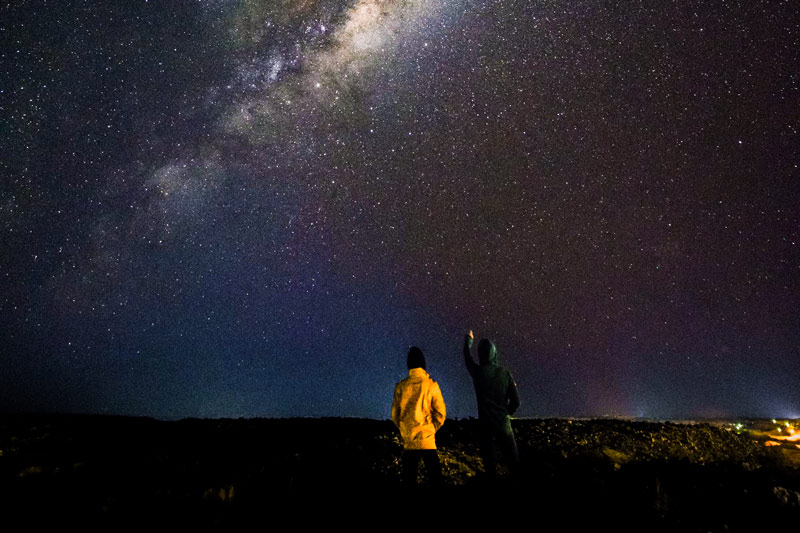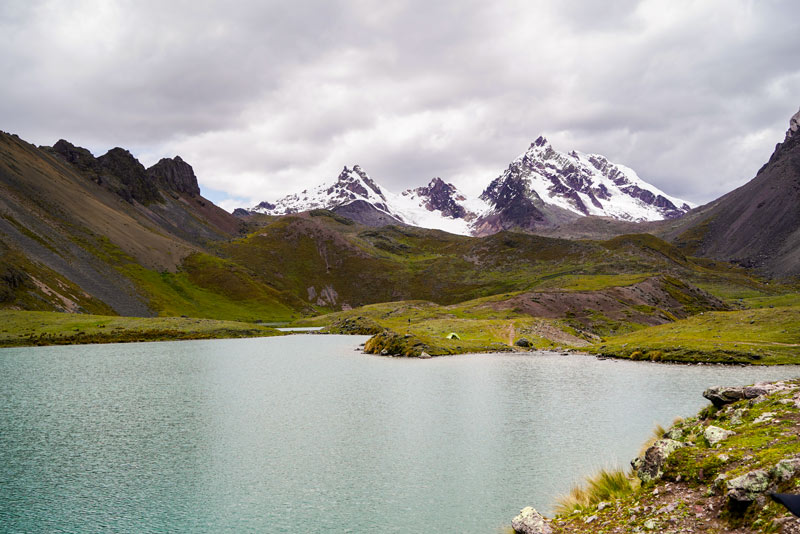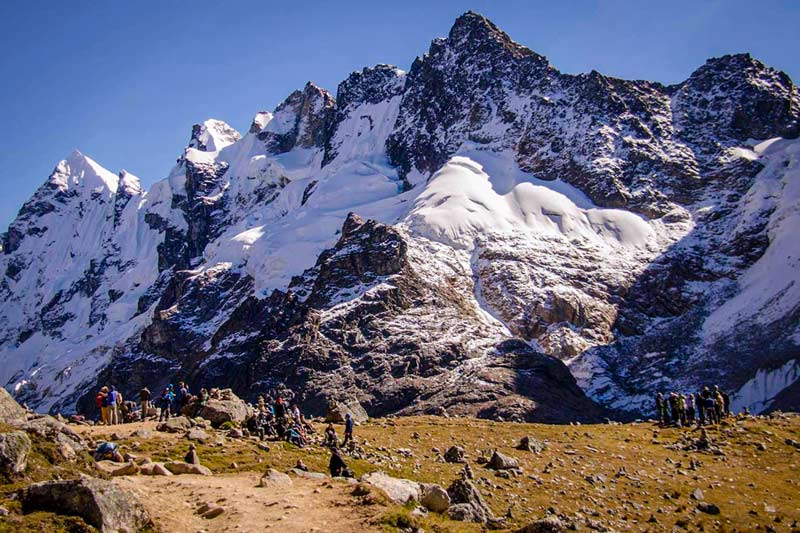Stellar skies for Astrotourism in Cusco
As time goes by, more and more travelers are discovering the magic of the night skies. Astrotourism, once a niche activity for amateur astronomers or campers, has become a trendy term for travel planning. It is an experience that combines science, culture and adventure by observing the night sky in places with minimal light pollution. Not only does it allow you to admire stars, planets and astronomical phenomena, but it is also an opportunity to connect with knowledge about the cosmos.
- What is Astrotourism?
- Astronomy in the Inca Culture
- Importance of Astrotourism
- What places to visit for Astrotourism in Cusco?
- Characteristics of Cusco
- Recommendations
- Frequently asked Questions
Astrotourism in Cusco is not only a window to the universe, but also an opportunity to promote sustainable tourism. This type of tourism encourages responsible practices, such as the use of efficient energy, reduction of light pollution, and respect for Andean cultural traditions. In addition, by choosing tour operators committed to sustainability, visitors help preserve the dark skies and natural landscapes that make Cusco a unique destination in the world. Astrotourism, in essence, invites us to reconnect with the universe in a way that benefits both people and the planet.
What is Astrotourism?
Astrotourism is defined as a travel experience focused on observing and connecting with the starry skies and celestial phenomena, such as the contemplation of constellations, planets, meteor showers, or unique events such as solar and lunar eclipses. This practice, which combines scientific wonder with natural beauty, has gained popularity in recent years, especially in destinations with ideal conditions for astronomical observation.
This type of tourism not only seeks clear skies free of light pollution, but also promotes activities such as night tours, moonlight walks, astronomical photography workshops and even wellness retreats to take advantage of the tranquility and spiritual connection that dark nights offer.
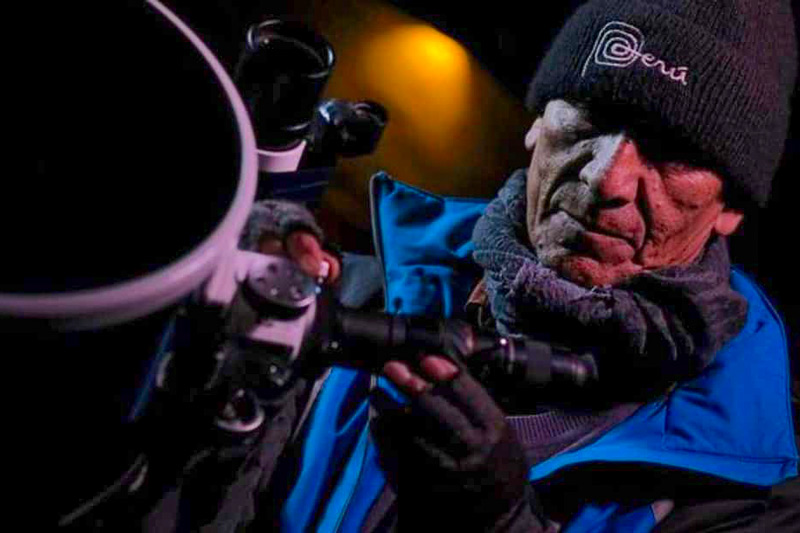
Preparing the telescope to observe the constellations
Astronomy in the Inca Culture
The Incas used the sky as a natural calendar. They identified constellations and celestial phenomena to regulate their agricultural cycles and religious ceremonies. This deep astronomical knowledge allowed the Incas to synchronize their daily lives with the rhythms of the cosmos, ensuring the prosperity of their crops and strengthening their connection with nature and their deities (Astronomy and Calendar of the Incas). They believed that the stars were sacred beings with a direct relationship with life on Earth. Among their most notable observations are:
- The Southern Cross , used as a reference for location and orientation, helped the Incas determine the seasons and guide their travels.
- The dark constellations , formed by the shadows in the Milky Way, were fundamental in the Andean worldview. Among them, the following stand out:
- Yacana (the cosmic flame) , which represented a llama with its young drinking from a celestial river. Its appearance at certain times indicated key moments for agriculture and livestock.
- Mach’acuay (the snake) , associated with health and the prevention of pests in crops.
- The solstices and equinoxes were key moments in the agricultural and ceremonial calendar. Sites such as Qoricancha and Machu Picchu were designed with precise alignments to record these events. For example, at the Temple of the Sun in Machu Picchu, sunlight penetrates through a specific window during the June solstice, marking the beginning of a new agricultural cycle.
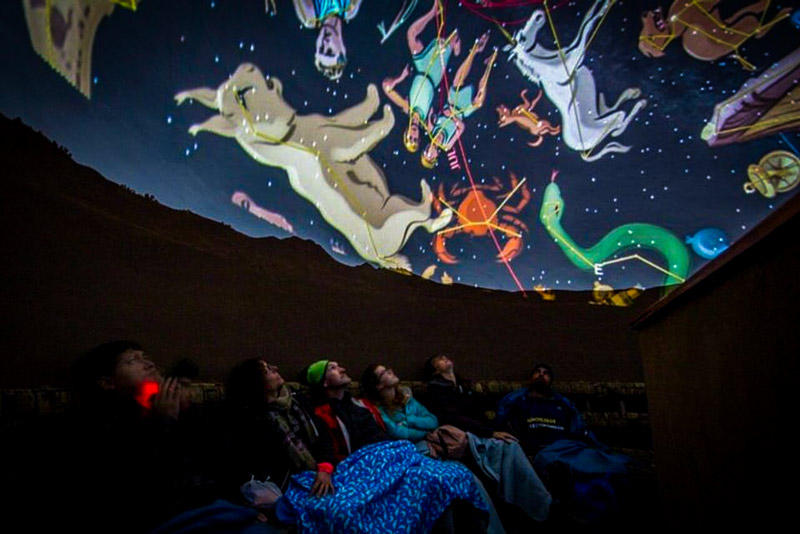
Constellation projection
Importance of Astrotourism
With light pollution growing at an alarming rate, it’s no wonder people are interested in experiencing dark nights, something few of us have the privilege of enjoying. A staggering 99% of the world’s population currently lives under night skies polluted to some degree by artificial light. Astrotourism not only raises awareness and appreciation for the nocturnal environment, but also creates economic incentives for communities to preserve their dark skies.
Astrotourism not only offers a unique and enriching experience for travelers, but also has the potential to generate significant social, economic and environmental benefits. By promoting this activity, we can learn from the successes and challenges of traditional daytime tourism to drive the growth of the astrotourism industry in a responsible and sustainable way.
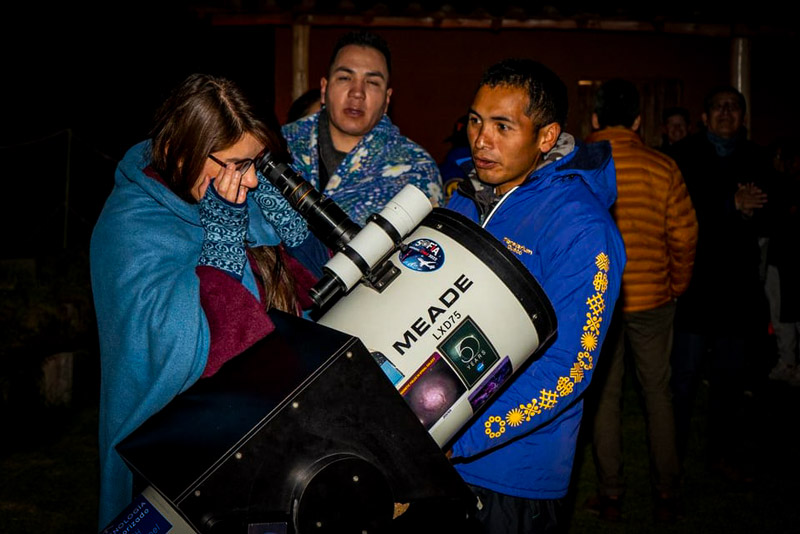
People observing stars through telescope
What places to visit for Astrotourism in Cusco?
The clarity of the Cusco sky, along with its incredible destinations in the middle of nature, give you the opportunity to discover more than one astrotourism site during your visit to Cusco. Below, we present the most impressive ones.
Sacred Valley of the Incas
The Sacred Valley is a vast valley surrounded by mountains, rivers and picturesque towns such as Pisac, Ollantaytambo and Urubamba. This place was fundamental for the Incas due to its fertility and its connection with the cosmos.
The Sacred Valley is one of the best destinations for astrotourism in Cusco due to its clear skies and low light pollution. Here, visitors can observe the Milky Way, constellations like the Southern Cross, and planets like Jupiter and Saturn with stunning clarity. Additionally, many tours include talks about Incan astronomy, which used the stars to guide their agricultural and ritual activities.
Seven Lagoons (Ausangate)
The Seven Lagoons in Ausangate are a group of glacial lakes located on the slopes of the Ausangate snow-capped mountain, one of the most sacred mountains for the Incas. This destination, located at more than 4,500 meters above sea level, is known for its crystal-clear waters and vibrant colors, ranging from turquoise to emerald.
The altitude and the absence of light pollution make the Siete Lagunas an exceptional place for stargazing. Here, the Milky Way is reflected in the waters of the lagoons, creating a magical effect. In addition, Ausangate is a sacred place in the Andean worldview, which adds a spiritual component to the experience.
Ausangate
The snowy Ausangate, with its 6,384 meters of height, is the fifth highest mountain in Peru and a sacred place for the Incas. Surrounded by glaciers, lagoons and Quechua communities, this destination is one of the most impressive in the region.
Ausangate offers one of the most authentic astrotourism experiences in Cusco. Its altitude and remote location guarantee extremely dark and clear skies. During the night, it is possible to observe constellations, planets and phenomena such as the Milky Way with incomparable clarity. In addition, local communities organize nightly ceremonies that connect visitors with the Andean worldview.
Sacsayhuaman
Sacsayhuamán is an impressive Inca fortress located on the outskirts of Cusco. With its massive stone walls and puma-head design, this archaeological site is one of the most important in the region.
Sacsayhuamán is not only a historical site, but also an ideal destination for astrotourism. From here, constellations such as the Southern Cross and the Milky Way can be observed with great clarity. In addition, the site is aligned with astronomical events such as the solstices, making it a perfect place to learn about Incan astronomy.
Three Golden Crosses (Paucartambo)
Tres Cruces de Oro is a natural viewpoint located in the province of Paucartambo, about 110 km from Cusco. This place is famous for its spectacular sunrise, known as the “Dawn of the Gods”, where the sun seems to emerge from between the clouds.
Although best known for its sunrises, Tres Cruces de Oro also offers a unique astrotourism experience. At night, the sky is filled with stars, and the altitude (3,700 meters above sea level) allows for clear observation of constellations and planets. In addition, the place has a mystical aura that attracts those seeking a spiritual connection with the cosmos.
Salkantay
The Salkantay, with its imposing 6,271 meters of height, is one of the most sacred and majestic mountains of the Peruvian Andes. The Salkantay offers one of the most spectacular astrotourism experiences in Cusco.
Its remote location and altitude guarantee extremely dark and clear skies, ideal for observing stars, constellations and the Milky Way. At night, the reflection of the stars in the nearby glacial lagoons creates a magical effect that seems straight out of a dream. In addition, the spiritual energy of Salkantay makes it a perfect place to perform Andean ceremonies under the stars, connecting visitors with nature and the sky.
Waqrapukara
Waqrapukara, which means “twisted horn” in Quechua, is an impressive archaeological site located in the Acos district, about 3 hours from Cusco. Less known than other tourist destinations in the region, this complex is located on top of a mountain and is surrounded by spectacular landscapes, such as deep canyons and winding rivers.
It is an ideal destination for astrotourism due to its remote location and altitude (approximately 4,300 meters above sea level), which guarantee dark and clear skies. In addition, its calm atmosphere away from the tourist bustle allows for a connection. Many visitors describe the experience as magical, especially when the stars illuminate the rock formations and Inca ruins.
Preparation for camping during an astrotourism experience in Cusco is key to fully enjoying this adventure under the stars. It is essential to bring appropriate equipment for the cold nights, such as thermal sleeping bags, warm clothing, and windproof tents. Also, items such as flashlights, binoculars or portable telescopes, and a camera to capture stars and the Milky Way cannot be missing.
Characteristics of Cusco
| Features | Description |
|---|---|
| Location | Cusco is located in southeastern Peru, in the Andean region, surrounded by mountains and valleys. |
| Altitude | It is located 3,400 meters above sea level. |
| Topography | The city is surrounded by hills and mountains, with narrow cobblestone streets that reflect its colonial and Inca design. |
| Weather | It has a temperate climate with distinct seasons, with a dry season (April-October) and a rainy season (November-March). |
| Architecture | Fusion of Inca and colonial styles, with impressive stone walls, baroque churches and mansions with carved wooden balconies. |
| Transportation | It is easily walkable in the historic center. For longer distances, cabs and public transportation are available. |
| Population | Cusco has about 500,000 inhabitants, with a large flow of tourists that enrich the cultural dynamics of the city. |
Recommendations
- Consider the ideal time of year to visit, the dry season (April to October) is ideal for clear skies.
- Acclimatize to Cusco’s altitude (3,400 meters above sea level) before engaging in strenuous activities. Take at least one day to rest.
- If you plan to trek or camp in places like Salkantay or Ausangate, make sure you are in good physical condition.
- Bring energy-rich and easy-to-prepare foods, such as nuts, cereal bars and chocolates.
- Stay hydrated, but avoid alcohol, as it can worsen the effects of altitude.
- Book specialized astrotourism tours for a safer and more enriching experience.
- Find out about weather conditions and bring rain gear if necessary.
- Avoid light pollution by using only the necessary light and turning off unnecessary electronic devices.
- Participate in Andean ceremonies with respect, valuing the spiritual connection that locals have with the cosmos.
- Enjoy moments of silence and contemplation under the stars, reconnecting with nature and the universe.
- Buy handicrafts and services from local guides to contribute to the economic development of the region.
- Be aware of your environmental impact and follow responsible practices during your trip.
Frequently asked Questions
1) What is astrotourism?
Astrotourism is a form of tourism that focuses on the observation and appreciation of the night sky, including stars, constellations, planets and astronomical phenomena such as the Milky Way, meteor showers or eclipses.
2) Why is Cusco a good destination for astrotourism?
Cusco is ideal for astrotourism due to its altitude (over 3,400 meters above sea level), which provides clearer skies and closer proximity to the stars. In addition, light pollution is minimal in rural areas and its Inca legacy includes a deep connection with astronomy, enriching the experience.
4) What destinations in Cusco are ideal for astrotourism?
Some of the best destinations include the Sacred Valley, Siete Lagunas (Ausangate), Salkantay, Sacsayhuamán, Tres Cruces de Oro (Paucartambo) and Waqrapukara.
5) Can I do astrotourism on my own or do I need a guide?
Although it is possible to do astrotourism on your own, it is advisable to hire a specialized guide or tour. Guides will not only take you to the best places, but they will also explain the connection between astronomy and Incan culture, enriching your experience.
6) Can I see the Milky Way from Cusco?
Yes, the Milky Way is visible from Cusco, especially in places with dark skies such as the Sacred Valley, Ausangate or the Seven Lagoons.
7) How can I minimize my environmental impact during astrotourism?
You can reduce your environmental impact by following these practices:
- Use red light flashlights to avoid affecting night vision or disturbing wildlife.
- Carry garbage bags and practice the “leave no trace” principle.
8) Are there cultural activities related to astrotourism in Cusco?
Yes, many astrotourism experiences in Cusco include cultural activities, such as:
- Andean ceremonies: Offerings to Pachamama (Mother Earth) or Inti (Sun) under the stars.
- Inca Astronomy Talks: Learn about how the Incas used the stars for agriculture and religion.
- Visits to archaeological sites: Places like Sacsayhuamán, aligned with astronomical events.
9) How does astrotourism contribute to sustainable tourism?
Astrotourism promotes sustainable tourism by encouraging the conservation of dark skies and reducing light pollution. It also supports local communities through jobs and tourism services.
Advice from people who have been there
 By: David S.
By: David S.“Nights of stars and magic“
“Astrotourism in Cusco is an experience that connects you with the universe in a unique way. I participated in a stargazing session in the Sacred Valley, where the sky became a canvas full of constellations. I ended up in awe, with a sense of peace and connection that I had never experienced before. Highly recommended. I advise you to bring warm clothes and a red light flashlight to enjoy this experience under the stars to the fullest.“
By Ticket Machu Picchu – Last updated, February 25, 2025
